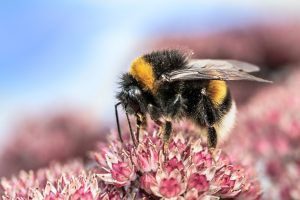13
Mar
Pesticide Exposure Alters Gene Expression in Bumblebees
 (Beyond Pesticides, March 13, 2019) A study on the impact of two neonicotinoid pesticides shows differential gene expression in bumblebees (Bombus terrestris) after exposure. Considering the current worldwide plight of insects, the authors of point to the cutting edge research as both a reason and a methodology to more carefully examine the effects of pesticides.
(Beyond Pesticides, March 13, 2019) A study on the impact of two neonicotinoid pesticides shows differential gene expression in bumblebees (Bombus terrestris) after exposure. Considering the current worldwide plight of insects, the authors of point to the cutting edge research as both a reason and a methodology to more carefully examine the effects of pesticides.
“Caste- and pesticide-specific effects of neonicotinoid pesticide exposure on gene expression in bumblebees” was published in the journal Molecular Ecology in early March. Researchers fed variable colonies with clothianidin or imidacloprid-laced sucrose. They analyzed gene expression in the heads of worker bumblebees and colony queens using RNA sequencing (RNA-seq), inspired by biomedical techniques. This approach allowed for new insight on what genes and pathways are affected by neonicotinoid exposure.
Study author Yannick Wurm, PhD, stated in a press release, “Our work demonstrates that the type of high-resolution molecular approach that has changed the way human diseases are researched and diagnosed, can also be applied to beneficial pollinators. This approach provides an unprecedented view of how bees are being affected by pesticides and works at large scale. It can fundamentally improve how we evaluate the toxicity of chemicals we put into nature.”
Clothianidin had a stronger impact on bumblebee colonies, changing the expression of 55 genes in worker bees and 17 genes in queens. The affected genes are involved in important biological processes such as mitochondrial function. Researchers noted with interest that there was almost no overlap between the genes that were impacted in queens versus workers. Comparatively, imidacloprid altered expression of only one gene in workers. The divergent effects of these two similar pesticides indicates distinct genetic mechanisms of toxicity.
Previous studies of neonicotinoids have found sublethal effects on bee learning and memory, cognition and problem solving, motor function, foraging performance, navigation abilities, and immune system – but have not delved deeply into the genetic process by which these deleterious effects occur.
“While newer pesticide evaluation aims to consider the impact on behaviour, our work demonstrates a highly sensitive approach that can dramatically improve how we evaluate the effects of pesticides,” says Dr. Wurm.
This study focuses on one type of bumblebee and finds diverse impacts, even within a colony. The novel finding highlights how little is known about the effects of pesticides on various insects. Lead author Joe Colgan, PhD, stated, “We examined the effects of two pesticides on one species of bumblebee. But hundreds of pesticides are authorised, and their effects are likely to substantially differ across the 200,000 pollinating insect species which also include other bees, wasps, flies, moths, and butterflies.”
The European Union banned the use of neonicotinoids in 2018, but these pesticides are still widely used in the U.S. and elsewhere. Beyond Pesticides holds the position that we must commit to complete transformation of our agricultural system if we hope to stave off the dire fate of total, devastating insect decline.
Beyond Pesticides is a resource for activists pushing to end pesticide use and adopt least-toxic, organic practices. Join the movement to end destructive pesticide use by engaging at the local, state and federal levels to transform our agricultural system. Our tools for change serves as a resource to help individuals organize their communities.
All unattributed positions and opinions in this piece are those of Beyond Pesticides.
Sources: Queen Mary University of London, EcoWatch










